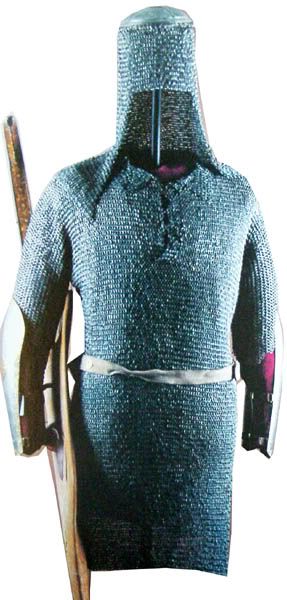
 |
|
|
#1 |
|
Member
Join Date: Mar 2005
Posts: 45
|
I have recently purchased this mail in oder to compete my XVII c. Polish "pancerny" display.
I am not certain of the age and origin nor if in fact it would ba an appropriate mail for my display. On some of the rings a "notched" pattern is visible. I have never encountered it before. My knowlege of mail is very limited and I would like to present this to you for opinions and comments. Any imput is much appreciated. |
|
|

|
|
|
#2 |
|
Member
Join Date: Dec 2004
Location: Bay Area
Posts: 1,625
|
Interestingly enough, it is butted, and not riveted. Would that suggest a more oriental origin?
|
|
|

|
|
|
#3 |
|
Member
Join Date: Dec 2004
Location: Poland, Krakow
Posts: 418
|
I hope you've received my emails (sorry for delay) about this one some time ago! You didn't mention then you want it for pancerny. Shouldn't this mail shirt be a little longer for pancerny warrior?
 By the way I'm curious if someone has seen such pattern on rings too? regards |
|
|

|
|
|
#4 |
|
Member
Join Date: Apr 2005
Posts: 190
|
Perkun,
Is there any variation in the thickness of the rings in the sleeves or at the lower extremity of the shirt? Typically mail from the 16th c. onward, regardless of origin, will show a thinner diameter of wire at these points to distribute weight best. There are exceptions, of course. The notches on the rings were probably intended to harden them, since they are butted. One wonders if it would not have been less work simply to rivet them. I have seen one riveted coat which was incontrovertibly of Polish workmanship-- each rivet had been fixed with a tool that simultaneously closed it and struck it with a tiny cross. TVV- riveted mail occurs fairly regularly in Eastern coats. Only occasionally in the late 18th (and very cleverly at that), and increasingly in the 19th century, did butting become common. It is doubtful whether butted mail was protective, most of what survives appears to have been for parade. Ham |
|
|

|
|
|
#5 | |
|
Member
Join Date: Dec 2004
Location: Poland, Krakow
Posts: 418
|
Quote:
|
|
|
|

|
|
|
#6 |
|
Member
Join Date: Mar 2005
Posts: 45
|
Wolviex,
I did get your emails, thank you for them! I do have my reservarions as to if it is appropriate for my display, but it will have to do for now  It is generally shorter than the ones in display im museums, but I have seen unusual ones in period iconography (short in lenght or long sleeves). I attach few pics of different mails. HAM, I am unable to provide you with answers as to thickness because I have not yet had a chance to examine the mail in person. Could you please explain to me how would the notches harden the rings? Do you know where was such process practiced? |
|
|

|
|
|
#7 |
|
Member
Join Date: Dec 2004
Location: Ann Arbor, MI
Posts: 5,503
|
You are well advised to wear it if you come to Detroit and decide to stroll Cass Avenue at 10 pm....
|
|
|

|
|
|
#8 |
|
Member
Join Date: Apr 2005
Posts: 190
|
Perkun,
Working metals repeatedly with tools gradually hardens them, hence armorers occasionally have to anneal (heat to re-soften) plates as they form them. The depressions on these rings were probably produced cold, with a blunt chisel or something similar. This would serve to harden them to some extent, but may have been done as a decorative measure as well. Based on the photos I am inclined to suggest that this mail is not especially old, though certainly caringly made; perhaps in the last century. Ham |
|
|

|
|
|
#9 | |
|
Member
Join Date: May 2005
Location: Merseyside, UK
Posts: 222
|
Quote:
|
|
|
|

|
 |
|
|